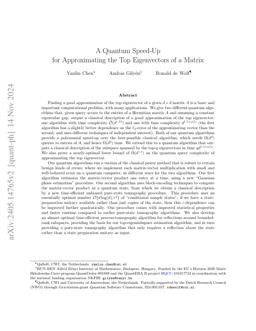2024-05-23
A Quantum Speed-Up for approximating the top eigenvectors of a matrix
Publication
Publication
Finding a good approximation of the top eigenvector of a given d×d matrix A is a basic and important computational problem, with many applications. We give two different quantum algorithms that, given query access to the entries of a Hermitian matrix A and assuming a constant eigenvalue gap, output a classical description of a good approximation of the top eigenvector: one algorithm with time complexity O~(d1.75) and one with time complexity d1.5+o(1) (the first algorithm has a slightly better dependence on the ℓ2-error of the approximating vector than the second, and uses different techniques of independent interest). Both of our quantum algorithms provide a polynomial speed-up over the best-possible classical algorithm, which needs Ω(d2) queries to entries of A, and hence Ω(d2) time. We extend this to a quantum algorithm that outputs a classical description of the subspace spanned by the top-q eigenvectors in time qd1.5+o(1). We also prove a nearly-optimal lower bound of Ω~(d1.5) on the quantum query complexity of approximating the top eigenvector. Our quantum algorithms run a version of the classical power method that is robust to certain benign kinds of errors, where we implement each matrix-vector multiplication with small and well-behaved error on a quantum computer, in different ways for the two algorithms. Our first algorithm estimates the matrix-vector product one entry at a time, using a new "Gaussian phase estimation" procedure. Our second algorithm uses block-encoding techniques to compute the matrix-vector product as a quantum state, from which we obtain a classical description by a new time-efficient unbiased pure-state tomography procedure.
| Additional Metadata | |
|---|---|
| Quantum Software Consortium | |
| Organisation | Algorithms and Complexity |
|
Chen, Y., Gilyén, A., & de Wolf, R. (2024). A Quantum Speed-Up for approximating the top eigenvectors of a matrix. |
|
| See Also |
|---|


